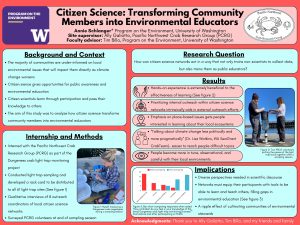Citizen Science: Transforming Community Members into Environmental Educators
Citizen science fills data gaps by allowing community volunteers to conduct research. These volunteers inherently become experts in the field they participate in. Although these individuals benefit from being involved in citizen science, we need widespread awareness of environmental issues in communities. The majority of communities are under-informed on local environmental issues that will impact them directly as climate change worsens. The aim of this study was to analyze the potential of citizen science to train community members to become environmental educators, not just scientists. Can citizen scientists create a ripple effect of environmental awareness and stewardship in their communities? To answer this question, I surveyed my peers at the PCRG larval Dungeness crab monitoring project, and conducted eight interviews with outreach coordinators of local community science networks. I discovered the distinction between external and internal outreach: recruitment and campaigning versus participant communications. I concluded that internal outreach must be prioritized to meet the needs of volunteers. External outreach goals would inherently be supported by the work of volunteers if they are given the tools needed to be educators. Through my time at PCRG, I developed a rack card to be distributed to all sites within the program. This would better prepare volunteers for educational opportunities with the public. Not only can citizen science fill research gaps, but it also has the potential to fill gaps in education. If networks equip their members with tools to teach others, greater place-based environmental education would occur, fostering informed and passionate environmental stewards.
